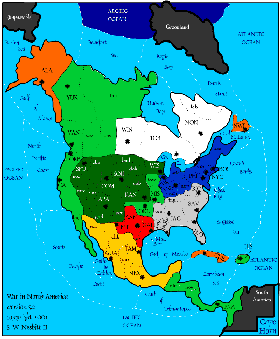War In North America
Created by: Will Nesbitt
Powers And Starting Positions:
Dominion of Canada
Home Centers: Montreal, Toronto, Winnipeg Units: * F-Montreal (South Coast) * F-Toronto (South Coast) * A-Winnipeg
United States of America
Home Centers: New York City, Cincinnati, Chicago, Philadelphia Controlled Centers: Boston, Cincinnati, Chicago, Philadelphia, California* Units: * F-Boston * A-Cincinnati * A-Chicago * F-Philadelphia (East Coast)
The USA is in civil disorder at gamestart, which breeds a very unique gamestart. The Union controls 5 centers but only starts with 4 units. Although California and Boston are controlled centers, these are not home (build) centers. New York is a home center, but New York is not controlled by the Union at gamestart. Because of the riots in NYC, the Union must "capture" this center to recover it as a build center.
Confederate States of America
Home Centers: Richmond , Savannah, Jackson Units: * A-Richmond * F-Savannah * A-Jackson
Republic of Texas
Home Centers: El Paso, San Antonio, Galveston Units: * A-El Paso * A-San Antonio * A-Galveston
Empire of Mexico
Home Centers: Guadalajara, Tampico, Mexico City Units: * A-Guadalajara * A-Tampico * F-Mexico City (Pacific/West Coast)
Native Federation
Home Centers: Apache, Comanche, Souix Units: * A-Apache * A-Comanche * A-Souix
The Souix, Commanche and Apache comprise a land-locked confederation of Native Americans. They do not posess the power to build fleets, but if their ghost dance is successful enough they may force others to build fleets for them. Specifically, if the Indian player conquers Boston or California, the first of these centers that is occupied by the Indian becomes a legal build center for the Indian player. However, the Indian player may only build fleets in these centers.
Quirks and Map Notes
Home Centers
Home Centers are listed above, but there are a few quirks here. New York City is in the Union territory but it is not a controlled Supply Center at the beginning of the game. It must be conquered like any other empty Supply Center. This represents the riots in NYC in opposition to the war and the fear among Irish Americans and others that freed slaves would reduce the price of labor. Boston on the other hand is controlled by the Union at gamestart, but Boston is not a build center for the Union.
Spokane and Kansas are in the Indian Territory, but these are not controlled by the Indians at gamestart. New Orleans and Florida are in the CSA but these are not controlled by the CSA at gamestart. Like NYC, these centers represent the effort required by these nations to mobilize for war, as well as the factions that were opposed to war within these nations. Like Boston, these centers are not build centers, so should be adjudicated as any other neutral center.
If the Indian player conquers Boston or California, the first of these centers that is occupied by the Indian becomes a legal build center for the Indian player. However, the Indian player may only build fleets in these centers.
Neutral Powers
The neutral units are on permanent hold and must be dislodged in order to take the supply centers. The Neutral Units can be supported by active powers. If the Russian Army is forced out of Alaska and has a legal retreat, the army will attempt to retreat to an open SC. Otherwise it will retreat off the board.
If ALASKA has not been conquered by a North American power by winter 1867, it will be purchased by the US and will become a US build center. Of course if the USA is no longer in play, then Alaska will remain a Russian province.
Cape Horn and the Oceans
As you recall, in 1865, there was no canal at Panama. The only way for ships to leave the Pacific Theater and enter the Atlantic Theater was by the long and arduous journey around Cape Horn. The Pacific Ocean borders Alaska, Bering Sea, Panama, the Pacific Coasts, and Gulf of Tehauntepec. Among other bodies of water, the Atlantic borders the Davis Strait and Panama. Cape Horn borders only the Atlantic and the Pacific Oceans.
Fleets that are in "Cape Horn" are considered somewhere between Venezuela and Columbia off the coast of South America. Fleets that are in the Oceans or Cape Horn are essentially considered "off board". Any number of any fleets from any nation may ply these waters during the same turn. Additionally, nothing can prevent a fleet from entering these waters. However, fleets at Cape Horn, the Atlantic or the Pacific can not be used in any supporting actions, and they may not participate in any military actions including actions against each other.
Fleets on the board may support fleets that are trying to return to the board. Fleets at "Cape Horn" may convoy if other normal conditions are met.
Coasts
Florida has one coast. Toronto and Montreal have two coasts (north and south). Philadelphia has two coasts (east and north).
Nicaragua, Honduras and Mexico City have two coasts (Atlantic and Pacific).
Bodies of Water
Gulf of St. Lawrence borders Upstate, Toronto (sc), Montreal (sc), New England , Newfoundland, Grand Banks and Davis Strait.
Chesapeake Bay borders Richmond , Philadelphia, the Grand Banks and the Sargasso Sea.
Great Lakes
Upstate borders Toronto. Because of Niagra Falls, fleets must enter Upstate or Toronto (south coast) to move from the Gulf of St. Lawrence to access the Great Lakes.
Michigan borders Toronto. However, fleets in the Great Lakes may legally move to any of the following provinces: Toronto (sc), Wisconsin, Chicago, Michigan, Philadelphia or Upstate.
